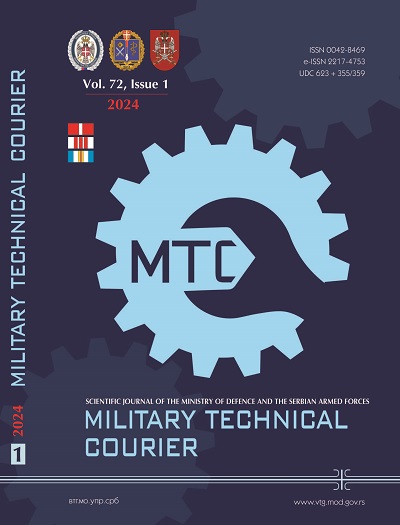Numerical analysis of the penetration process of a 30mm armor-piercing fin-stabilized discarding sabot projectile
Abstract
Introduction/purpose: In recent times, with the tendency to develop new types of armor-piercing ammunition, constant investments in the development of new types of armored obstacles is necessary. Obstacles made of high-alloy steel plates are still the best form of protection against larger caliber ammunition. There are a number of factors to consider when selecting an alloy, including the weight, dimensions, intended use, desired ballistic performance, and costs. According to that, a numerical analysis of penetration of a 30mm armor-piercing fin-stabilized discarding sabot projectile into the steel alloy Weldox 460 plates of different thicknesses at a distance of 1000m with a velocity of 1300m/s is presented in this paper.
Methods: The stresses and deformations of the penetration effect were calculated through numerical analysis and finite element modeling. To specify material characteristics, the Johnson-Cook material model and the fracture of materials model have been utilized. In order to define models and carry out numerical calculations, the software packages FEMAP and LS Dyna have been used in this paper.
Results: For a numerical analysis of the penetration process of this projectile type against armor obstacle, four different armor plate thicknesses are calculated: 10mm, 50mm, 100mm, and 110mm. For each of them, the results are shown in a form of stress and displacement, so that the interaction phenomena between the sub-projectile and the armor plate can be described.
Conclusion: Modeling the impact on armor-piercing obstacles is extremely difficult, time-consuming, and complex, and the resulting models very successfully (or with some deviation) approximate the real problem of projectile penetration. One of the most effective methods for solving problems of this kind and others of a similar nature in recent times is the finite element method analysis. The material and the target dimensions, as well as the ballistic parameters and the material of the projectile have the biggest influence on projectile penetration. The target's resistance to penetration increases when all input parameters are maintained at the same level and its thickness is increased, and vice versa.
References
Flores-Johnson, E.A., Shen, L., Guiamatsia, I. & Nguyen, G.D. 2014. Numerical investigation of the impact behaviour of bioinspired nacre-like aluminium composite plates. Composites Science and Technology, 96, pp.13-22. Available at: https://doi.org/10.1016/j.compscitech.2014.03.001.
German, R.M. 2022. Sintered tungsten heavy alloys: Review of microstructure, strength, densification, and distortion. International Journal of Refractory Metals and Hard Materials, 108, art.number:105940. Available at: https://doi.org/10.1016/j.ijrmhm.2022.105940.
Gyürösi, M. 2019. Mecar's M929 APFSDS-T ammunition undergoes trials in Slovakia. Janes, 17 May [online]. Available at: https://www.janes.com/defence-news/news-detail/mecars-m929-apfsds-t-ammunition-undergoes-trials-in-slovakia [Accessed: 02 September 2023].
Heuzé, O. 2012. General form of the Mie–Grüneisen equation of state. Comptes Rendus Mécanique, 340(10), pp.679-687. Available at: https://doi.org/10.1016/j.crme.2012.10.044.
Liu, Z.S., Swaddiwudhipong, S. & Islam, M.J. 2012. Perforation of steel and aluminum targets using a modified Johnson–Cook material model. Nuclear Engineering and Design, 250, pp.108-115. Available at: https://doi.org/10.1016/j.nucengdes.2012.06.026.
Magier, M. 2010. The Conception of the Segmented Kinetic Energy Penetrators for Tank Guns. Journal of Applied Mechanics, 77(5), art.number:051802. Available at: https://doi.org/10.1115/1.4001714.
-Nammo. 2023. 30mm x 173 APFSDS-T. Nammo.com [online]. Available at: https://www.nammo.com/product/our-products/ammunition/medium-caliber-ammunition/30-mm-seriess/30mm-x-173-apfsds-t/ [Accessed: 02 September 2023].
Pantović, R., Živković, M., Milovanović, V. & Miloradović, N. 2023. Numerical analysis of the penetration process of a 30mm armor-piercing projectile. Vojnotehnički glasnik/Military Technical Courier, 71(3), pp.678-710. Available at: https://doi.org/10.5937/vojtehg71-43502.
Rezasefat, M., Mostofi, T.M., Babaei, H., Ziya-Shamami, M. & Alitavoli, M. 2018. Dynamic plastic response of double-layered circular metallic plates due to localized impulsive loading. Proceedings of the Institution of Mechanical Engineers, Part L: Journal of Materials: Design and Applications, 233(7), pp.1449-1471. Available at: https://doi.org/10.1177/1464420718760640.
-Sturgeon's House. 2018. Tanks guns and ammunition. Sturgeonshouse.ipbhost.com [online]. Available at: https://sturgeonshouse.ipbhost.com/topic/1086-tanks-guns-and-ammunition/page/10/ [Accessed: 02 September 2023].
Sun, M., Cao, W., Hu, D., Zhang, N. & Chi, R. 2021. Effect of Cover Plate on the Ballistic Performance of Ceramic Armor. Materials, 14(1), art.number:1. Available at: https://doi.org/10.3390/ma14010001.
Wang, X. & Shi, J. 2013. Validation of Johnson-Cook plasticity and damage model using impact experiment. International Journal of Impact Engineering, 60, pp.67-75. Available at: https://doi.org/10.1016/j.ijimpeng.2013.04.010.
Wilkins, M.L. 1999. Computer Simulation of Dynamic Phenomena. Heidelberg: Springer Berlin. Available at: https://doi.org/10.1007/978-3-662-03885-7.
Copyright (c) 2024 Predrag R. Pantović, Aleksandar V. Kari, Aleksa D. Aničić, Miroslav M. Živković, Vladimir P. Milovanović

This work is licensed under a Creative Commons Attribution 4.0 International License.
Proposed Creative Commons Copyright Notices
Proposed Policy for Military Technical Courier (Journals That Offer Open Access)
Authors who publish with this journal agree to the following terms:
Authors retain copyright and grant the journal right of first publication with the work simultaneously licensed under a Creative Commons Attribution License that allows others to share the work with an acknowledgement of the work's authorship and initial publication in this journal.
- Authors are able to enter into separate, additional contractual arrangements for the non-exclusive distribution of the journal's published version of the work (e.g., post it to an institutional repository or publish it in a book), with an acknowledgement of its initial publication in this journal.
- Authors are permitted and encouraged to post their work online (e.g., in institutional repositories or on their website) prior to and during the submission process, as it can lead to productive exchanges, as well as earlier and greater citation of published work (See The Effect of Open Access).

